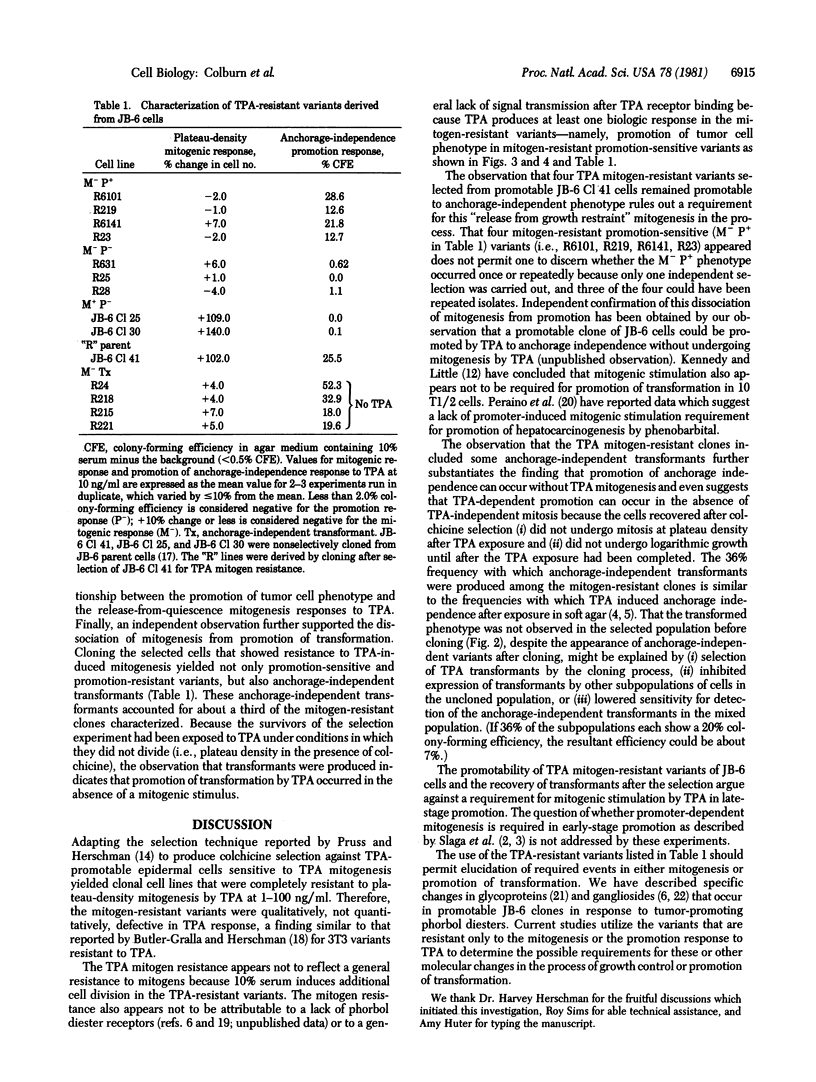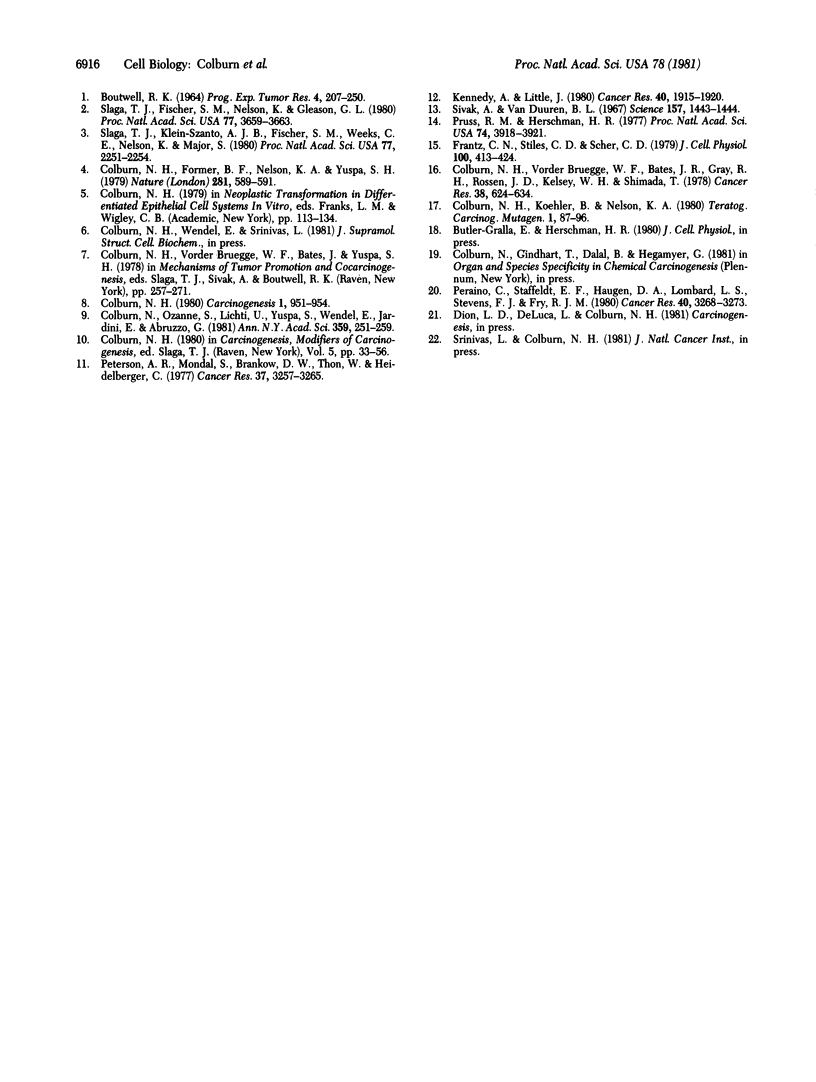Abstract
The JB-6 mouse epidermal cell line has been used as a model system for studying the mechanism of late-stage promoter-dependent preneoplastic progression. The studies reported here are concerned with determining whether there is a requirement for mitogenic stimulation in promotion of anchorage independence and tumorigenicity in JB-6 cells. Such a requirement would predict that variants selected for 12-O-tetradecanoylphorbol 13-acetate (TPA) mitogen resistance would also be promotion resistant. Promotion-responsive cell lines have been selected for resistance to TPA-induced mitogenic stimulation at plateau density by cotreatment with colchicine and removal of mitogen-responsive colchicine-detached cells. The selected TPA-resistant population of cells showed a mitogenic response that was diminished by a factor of four but showed no diminution in the promotion-of-anchorage-independence response to TPA. Mitogen-resistant clonal lines derived from the selected population fell into three phenotypic classes when assayed in soft agar: (i) anchorage-independent transformants; (ii) variants resistant to promotion of anchorage independence by TPA; and (iii) variants sensitive to promotion by TPA. The existence of the latter class (i.e., the mitogen-resistant promotable variants) indicates a lack of obligatory causal relationship between TPa-induced mitogenesis and late-stage promotion and, thereby suggests that the two events can be dissociated.
Full text
PDF




Images in this article
Selected References
These references are in PubMed. This may not be the complete list of references from this article.
- BOUTWELL R. K. SOME BIOLOGICAL ASPECTS OF SKIN CARCINOGENISIS. Prog Exp Tumor Res. 1964;4:207–250. doi: 10.1159/000385978. [DOI] [PubMed] [Google Scholar]
- Colburn N. H., Bruegge W. F., Bates J. R., Gray R. H., Rossen J. D., Kelsey W. H., Shimada T. Correlation of anchorage-independent growth with tumorigenicity of chemically transformed mouse epidermal cells. Cancer Res. 1978 Mar;38(3):624–634. [PubMed] [Google Scholar]
- Colburn N. H., Former B. F., Nelson K. A., Yuspa S. H. Tumour promoter induces anchorage independence irreversibly. Nature. 1979 Oct 18;281(5732):589–591. doi: 10.1038/281589a0. [DOI] [PubMed] [Google Scholar]
- Colburn N. H., Koehler B. A., Nelson K. J. A cell culture assay for tumor-promoter-dependent progression toward neoplastic phenotype: detection of tumor promoters and promotion inhibitors. Teratog Carcinog Mutagen. 1980;1(1):87–96. doi: 10.1002/tcm.1770010109. [DOI] [PubMed] [Google Scholar]
- Colburn N. H., Ozanne S., Lichti U., Ben T., Yuspa S. H., Wendel E., Jardini E., Abruzzo G. Retinoids inhibit promoter-dependent preneoplastic progression in mouse epidermal cell lines. Ann N Y Acad Sci. 1981 Feb 27;359:251–259. doi: 10.1111/j.1749-6632.1981.tb12751.x. [DOI] [PubMed] [Google Scholar]
- Colburn N. H. Tumor promoter produces anchorage independence in mouse epidermal cells by an induction mechanism. Carcinogenesis. 1980;1(11):951–954. doi: 10.1093/carcin/1.11.951. [DOI] [PubMed] [Google Scholar]
- Driedger P. E., Blumberg P. M. The effect of phorbol diesters on chicken embryo fibroblasts. Cancer Res. 1977 Sep;37(9):3257–3265. [PubMed] [Google Scholar]
- Frantz C. N., Stiles C. D., Scher C. D. The tumor promoter 12-O-tetradecanoyl-phorbol-13-acetate enhances the proliferative response of Balb/c-3T3 cells to hormonal growth factors. J Cell Physiol. 1979 Sep;100(3):413–424. doi: 10.1002/jcp.1041000305. [DOI] [PubMed] [Google Scholar]
- Kennedy A. R., Murphy G., Little J. B. Effect of time and duration of exposure to 12-O-tetradecanoylphorbol-13-acetate on x-ray transformation of C3H 10T 1/2 cells. Cancer Res. 1980 Jun;40(6):1915–1920. [PubMed] [Google Scholar]
- Peraino C., Staffeldt E. F., Haugen D. A., Lombard L. S., Stevens F. J., Fry R. J. Effects of varying the dietary concentration of phenobarbital on its enhancement of 2-acetylaminofluorene-induced hepatic tumorigenesis. Cancer Res. 1980 Sep;40(9):3268–3273. [PubMed] [Google Scholar]
- Pruss R. M., Herschman H. R. Variants of 3T3 cells lacking mitogenic response to epidermal growth factor. Proc Natl Acad Sci U S A. 1977 Sep;74(9):3918–3921. doi: 10.1073/pnas.74.9.3918. [DOI] [PMC free article] [PubMed] [Google Scholar]
- Sivak A., Van Duuren B. L. Phenotypic expression of transformation: induction in cell culture by a phorbol ester. Science. 1967 Sep 22;157(3795):1443–1444. doi: 10.1126/science.157.3795.1443. [DOI] [PubMed] [Google Scholar]
- Slaga T. J., Fischer S. M., Nelson K., Gleason G. L. Studies on the mechanism of skin tumor promotion: evidence for several stages in promotion. Proc Natl Acad Sci U S A. 1980 Jun;77(6):3659–3663. doi: 10.1073/pnas.77.6.3659. [DOI] [PMC free article] [PubMed] [Google Scholar]
- Slaga T. J., Klein-Szanto A. J., Fischer S. M., Weeks C. E., Nelson K., Major S. Studies on mechanism of action of anti-tumor-promoting agents: their specificity in two-stage promotion. Proc Natl Acad Sci U S A. 1980 Apr;77(4):2251–2254. doi: 10.1073/pnas.77.4.2251. [DOI] [PMC free article] [PubMed] [Google Scholar]



